PORTUGAL 2025
The Algarve
The Algarve is the southernmost region of mainland Portugal, a collection of cities and areas along the coast. Famous for it's beaches and summer destinations.

As we drive away from Lisbon, the crazy traffic eases, and the roads become a lot easier to navigate. Our first stop along the way is the small town of Sines, a good place to stretch the legs and have a pizza lunch. Not much more to see in Sines, and we continue South after lunch. Along the way we get some of the first of heavy rain.


Lagos
We safely arrived at Casa de Moura in Lagos, but it was very hard to find parking in the narrow streets of the old town. We were able to drop our luggage and get directions to a bigger lot where we could park and walk back, so happy we made a new umbrella purchase. Casa de Moura is a small hotel with 8 rooms, a small pool and deck area, and a rooftop area where they have views and serve breakfast. It has a heavy Moroccan feel and smells like incense.











The rain finally let up a bit, so we wandered around the old town area to get our bearings.















March 2


We had views of the old city walls and church towers while we ate breakfast on their rooftop patio.


After breakfast we decided to grab the car and drive back west for a day in the Algarve. It was a sunny day of lighthouses and Sea cliffs; our first stop being Cabo de São Vicente, the western most point. Up until the 14th Century, it was considered the end of the world. The lighthouse on the top of the cliffs is one of the worlds brightest, visible from almost 100 kilometers away.
















The Fort of Santo António de Belixe (Fort of Saint Anthony of Beliche), which is also referred to as Fortaleza de Belixe is located on Cape St. Vincent. The original date of construction is unknown but the fort was already in existence in the 16th century as it contains the coat of arms of King Sebastian (1554–1578). One theory is that the fort was built by order of King Manuel I (1469–1521), who lived at the nearby Cape St. Vincent at the beginning of the 16th century.











Next up along our western exploration was Sagres and the Fortaleza de Sagres.


Fortaleza de Sagres is defined by a lengthy curtain wall and gateway to the fort. This curtain wall, adapted to install defence artillery, substituted for the primitive 15th century fortification. The neo-classic Square Door's pediment bears a coat-of-arms and an inscription dated 1793, that reads the name of the Algarve Kingdom's Governor and Captain-General, at that time, Dom Nuno Jose Fulgencio Joao Nepomuceno de Mendonca Moura. Yeah, that's a mouthful.

Aerial view of the curtain wall and fort

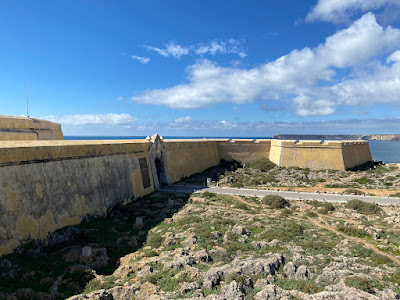











A Voz do Mar (Chamber of Sound) is an installation inside the fort walls at Sagres. It is a circular maze that enhances the sounds of the waves crashing below from the sea caves 100 meters below. The sound carries within the circle, and your voice echoes as your circle towards the middle.







From here you can see the lighthouse at Cabo de São Vicente that we visited earlier in the day.













Heading back to Lagos, and we stopped at the cliffside boardwalks along the Atlantic Ocean, known as Ponta da Piedade. The limestone along this stretch has been worn by years of storms creating an amazingly rugged and beautiful coastline of caves, stacks and cliffs. Hidden in the waters below are hundreds of years of shipwrecks.


















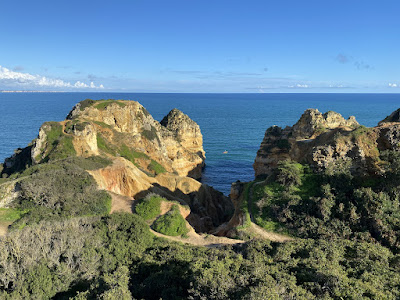














After a bit of a break in our room, we take a short walk back into the old town for dinner.

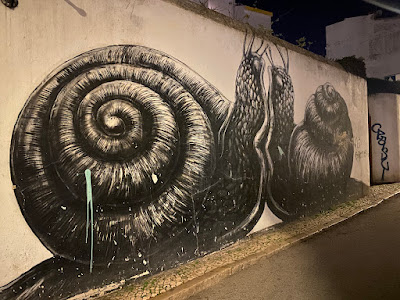


Hidden up a flight of stairs, Casa do Prego is a nice restaurant that had a good mix of food, and great service.



Norine was pretty happy to find a place that made great Sangrias, and I found a local beer that would become my favourite.
March 3
I had booked a Boat tour for the morning, but due to the weather it was rescheduled for the afternoon.



We had 3 of the 4 seasons during breakfast, great views during a Thunder and Lightning storm, then heavy rain followed by Blue sky and rainbows, all in less than an hour.







Just past the old town center is the marina and harbour leading out to the Atlantic Ocean.


Behind the Marina and around the corner is Praia de São Roque (Praia is Portuguese for Beach).




After a nice walk along a mostly deserted beach, we had some appetizers at The Bahia Beach Bar.






By the time we were doing the Speedboat tour with Days of Adventure, the weather was great, so glad they rescheduled us.










































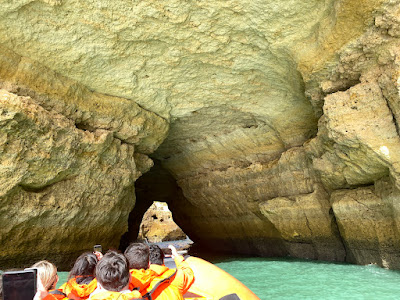









This speedboat tour was crazy, we flew at top speed to get to the different caves, and between each cave, we launched over waves, smashing back down... a collective ooof sound from the entire boat as we smashed back down on the other side of waves.
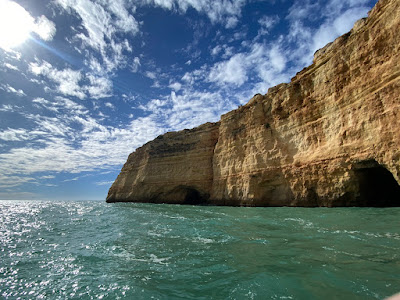







Benagil Cave is the main tourist attraction in Benagil. Out of all sea caves that dot the Algarve coastline between Lagos and Albufeira, the Benagil Cave is the only one that has been eroded both from the side and from the top. This unique natural process has resulted in an opening in the ceiling that allows the sunlight to brighten up the grotto and the beach that it hides. In 2023, after concerns of over-tourism was raised, only sanctioned tours are permitted in the grotto, watercraft are not permitted to land on the beach. So when you see that photo someone posts of people on the beach, it was taken before 2023, or it is a fake.



















Back at the marina, we may have to take back pills after that crazy ride. As we are walking back to the hotel, I step out of the way of a group, and then turn right into a short concrete pole and split my shin open. I'm returning to the days of stupid travel injuries.




Apparently going on a boat ride can make you hungry, We went for Italian at this amazing little restaurant, and the food served in a frying pan was so good I forgot to take a picture until I was finished. We talked in line and sat next to a very nice family from Germany. One of their daughters spent time abroad at a Canadian University in Ottawa. We all shared our concerns about the current political climate and had some good laughs.
March 4
We checked out of our hotel after going to see the Church of Saint Anthony, but it was closed, even though the sign said open. We grabbed some large bandaids for my shin, and left Lagos.



Our first stop was the town of Silves.
The red sandstone castle Castelo de Silves dates back to the period when Silves was transformed into a strong occupation base and commercial centre of great prosperity under Roman rule. Around 716, the Moorish conquest brought gigantic changes to the fortress that the Romans had built above the city. Situated on the highest point of the hill on which the city stands, the fortress was reinforced with a new walled enclosure with towers and armour, which extended along the right bank of the stream.


We were very surprised to see storks nesting around the town.







When you find a parking spot in these small towns, you take it, even if it means you have to walk uphill a ways to get to the castle.

















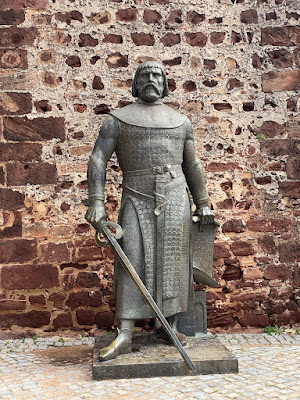



Sé Catedral de Silves was originally a mosque, built during the Moorish rule of the Iberian Peninsula, it was later mostly restructured and converted into a Catholic cathedral after 1268. It received numerous updates through to the 16th century.











The roads we encounter in this part of Portugal are quite varied, from narrow cobblestone streets to nice Highways with tunnels and overpasses. At least we weren't slowed down by horse and buggies.



We made a stop at the Church of São Lourenço on the way to Faro, it was also closed.





Faro
Arriving in Faro, we checked in to 7 styles apartments by Raspberry Cascade in the heart of Faro old town, we had some pizza and headed to Loule for Carnaval.





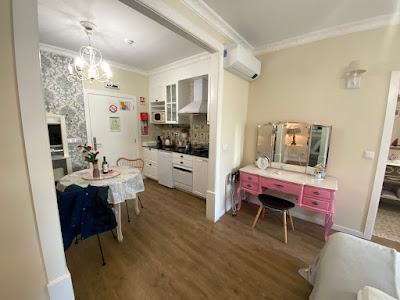





Carnaval de Loulé is the oldest continuous pre-Lenten party in Portugal, with 119 years of celebrations.It is massively popular, and we had to search for a bit to find somewhere we could park and walk back. Luckily we found a spot that had high weeds, but the cars collision detection didn't want to go there until Norine got out and stomped the weeds down.


We knew we were walking the right way as we followed crowds of people all dressed up for the party.









The theme of this years Carnaval was drought, so everything was supposed to tie into that, some were obvious, some were political, and some were just strange.The entire time, music was blasting, people were dancing, and confetti and streamers were being thrown by the handfuls the entire time.










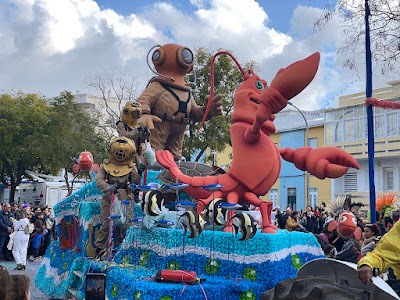





No Carnaval is complete without scantily clad dancers wearing elaborate feather costumes... or just body paint.
















There was even a float representing the rising tensions between Mexico, Canada and the USA.













It's hard to tell by this picture, but we were covered in Confetti. We left the area after the parade started repeating the loop that started 2 hours earlier. As we are walking back to the car, the streets outside the area are lined with street sweepers waiting to come in and clean up the hundreds of pounds of shredded paper and streamers. We would be finding confetti for weeks.
We drove back into Faro, and we wandered the town after finding a parking lot on the edge of town.






Surprised again by more stork nests, and of course if you find a Ginja store, you have to stop for a shot in a chocolate glass.





The tiles throughout Portugal are impressive, and the "Commemorative Panel of Christopher Columbus Passing by Faro" is impressive with it's detailed description in small blue and white tiles describing his stop in Faro in 1493 and recalling the explorer’s different voyages between the Iberian Peninsula and the “New World.”.


If you have ever travelled to Europe, you know there is always some beautiful monument covered in scaffolding. Dinner would be waffles covered in Bananas and Nutella from a seaside stand.
March 5
We spent a rainy morning checking out the cathedrals of Faro.


The Igreja do Carmo was originally constructed in 1719, but was heavily damaged during the 1755 Earthquake.








The side altars (or whatever you call them), are as detailed as many of the front altars we have seen in other churches.






The Capela dos Ossos (Chapel of Bones) is housed in a small extension to the Church. The inscription above the entrance to the chapel reads "Para acqui a considerar que a este estado has-de chegar"... "Stop here and consider, that you will reach this state too". The Capela dos Ossos contains 1245 skulls.









Igreja de S.Pedro was built in the 15th century by sailors due to the growth of shipping and maritime exploration at the time. In 1577 the sailors built a new church, it was still not completed 10 years later. Additions and changes were made over the next 200 years, and the church had to be rebuilt again after the 1755 earthquake.








The winding cobblestone streets, arches and alleyways give Faro a truly historic feel with limited vehicles in the old town.



Catedral de Faro, aka Igreja de Santa Maria, was consecrated in the late 13th century and built on the remains of an ancient Paleochristan basilica that had been converted into a mosque. In 1596, the church and the city were ransacked and set on fire by the Earl of Essex. Of the Gothic era, only the sanctuary chapels, the facade tower and the walls of the nave survived, while the altars and the wooden ceilings were destroyed. The interior was later rebuilt in Mannerist style during the 17th century.




Views from the tower were amazing.























Since we hadn't seen enough cathedrals, we went back to the Church of São Lourenço that was closed the day before.
The Church of São Lourenço dates back to the 16th century. Its exterior is extremely plain, characteristic of the style common to rural surroundings. The interior features striking blue and white 18th century tiled panels which depict Old Testament scenes. There are also panels dating back to the 16th century, in all probability part of the original décor. On the lateral walls, there are two 17th century panels depicting scenes from the life of Saint Laurence, the church´s patron.

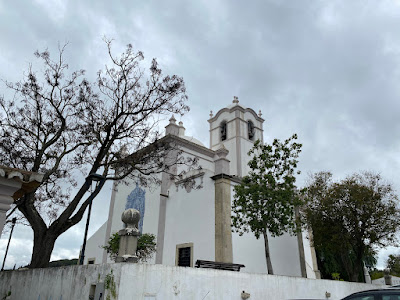


It was well worth a little back-tracking to see the inside of this church, as it is so different from everything else we have seen. Excuse the picture quality, as they don't allow photographs, so these are the postcards I bought to help the restoration of the tiles.





From the Algarve region, we headed towards the town of Tavira, and then North towards Evora.


